As an Amazon Associate I earn from qualifying purchases.
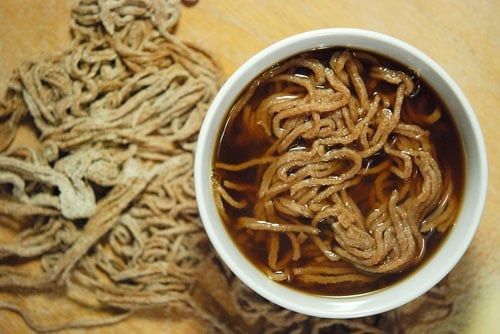
Making stocks and broths are among the core skills of any good cook, and it is a labor or love I embrace wholly. As a hunter, angler and a gardener, I can often make a first-class stock solely with ingredients I’ve grown, caught or shot. This to me is deeply satisfying. Venison stock is one of my mainstays throughout the year.
While some will make a stock without vegetables, I am not among them. They add so much to the final flavor of a stock and can transform it from an additive into a full-fledged broth suitable for drinking on cold days. Incidentally, while I use stock and broth interchangeably, technically a stock is a base and a broth something you can serve on its own; generally a broth is more flavorful and better seasoned than a stock.
Other than the venison, my essentials are: Onions or leeks, carrots, celery, bay leaves, parsley. I will add other herbs as appropriate, most often rosemary and thyme, and sometimes juniper berries. Secret weapon for venison stock: parsnips. Their sweetness brings a lot to the party.
First step is roasting the bones. I like darker, fuller stocks and this is what does it. I roast my deer bones at 400°F for an hour or so, until they are yummy-looking. Incidentally, meat makes better broth, so add some if you can. Secret trick: Save all the gnarly, sinewy bits and trim not even fit for the grinder and roast them along with the bones; don’t include bloodshot meat, though.
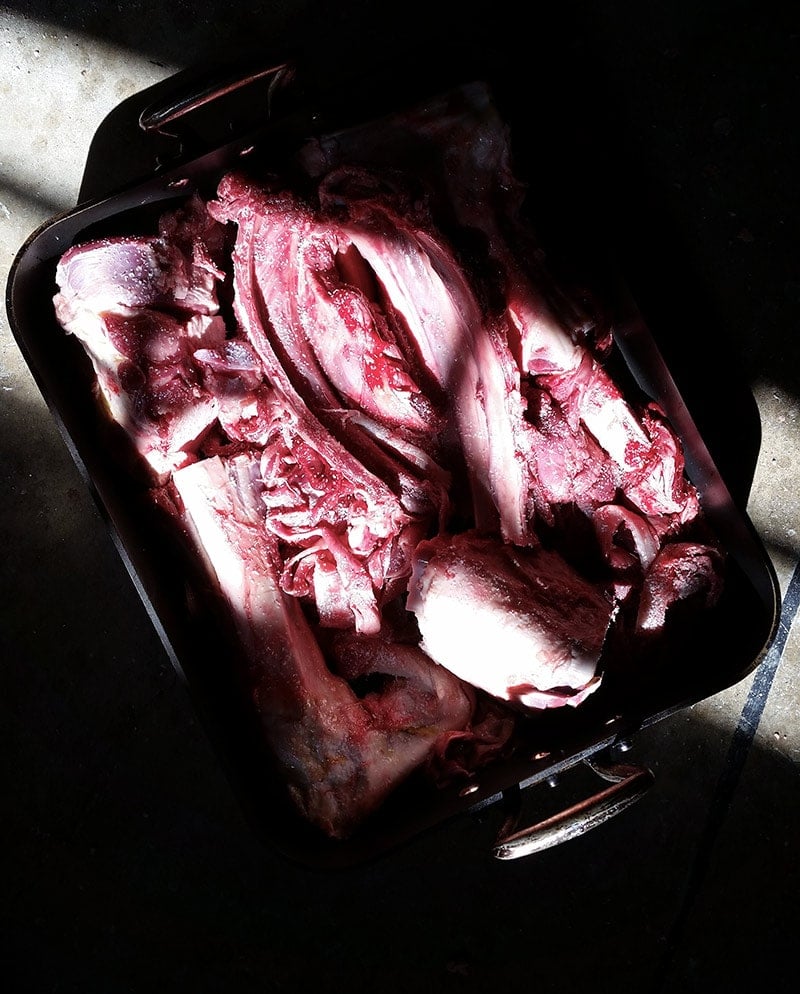
Next cram your bones and trim into the stockpot and cover with cold water by several inches. Cold water will you produce more collagen, and it’s collagen from the joints and cartilage and skin that builds body in your stock by making it thicker than water. You only get this by letting the water heat gradually. Secret trick: Go to the butcher and buy a calf’s or pig’s foot and add it to the pot (don’t roast it, though). It will add a huge amount of body to your broth.
Bring the broth to a boil and skim off any scum that floats to the surface. After the surface is clear, reduce the heat to a bare simmer. You want it to shimmy, not roil, not even bubble too much. A boiled stock will turn cloudy, and the higher temps can extract bitter flavors from the bones. Let it do this for several hours. How long? Up to overnight.
After the meat has infused the water to your liking — 4 hours is a minimum for me — add your veggies, roughly chopped. Remember that old, crappy veggies will not improve by cooking them. That said, the ends of things make great stock, as do onion skins, which will help turn a broth a lovely brown. Stir in your nice vegetables and let it cook for another 90 minutes to 2 hours. No more.
After this, strain everything out. Grab all the big stuff with tongs first, then set a paper towel into a fine mesh sieve. Ladle your venison stock through this into a large bowl or plastic bin. Is all of this necessary? Yes. Unless you want a mucky, cloudy stock. And it is more than aesthetics: The impurities are just that – impure, and add off-flavors to your otherwise wonderful brew.
Once your stock is strained, clean the stockpot or pour the strained liquid into another one. Now you can reduce it if you want to.
This is also the time you can salt the stock. Stock gets saltier the longer you cook it down because salt does not evaporate with the water. So add it close to the end and you will know what you’re getting. If you’re doing demi-glace, don’t salt at all.
All of this takes time, but not a lot of it is active. And the process is comforting to me, as much so as the reward.
Venison Broth
Ingredients
- 4 pounds venison bones, with some meat on them
- 4 tablespoons olive oil
- Salt
- 1 tablespoon crushed juniper berries (optional)
- 2 tablespoons fresh rosemary
- 1 tablespoon crushed black peppercorns
- 1 tablespoon dried thyme
- 4 bay leaves
- 1 medium onion, chopped
- 2 large carrots chopped
- 2 celery sticks chopped
- About 1/2 of a bunch of parsley chopped
Instructions
- Coat the bones with olive oil and salt well, then roast in a 400°F oven until brown. If you can stand it, keep some meat on the bones — trim and shanks are ideal for this. It will make a better broth. Put the bones in a large stockpot. I saw the bones into large pieces with a hacksaw; this lets me fit more bones into the pot, again, making a richer broth. Cover with water and bring to a simmer over medium-high heat.
- Skim the froth that forms on the surface and simmer very gently for at least 4 hours; I let it go overnight. You want the broth to steam and burble a little, not roil.
- Add the remaining ingredients and simmer for another 2 hours.
- Using tongs, grab out all the bones and large bits and discard. Set a paper towel in a fine-mesh sieve that is itself set over another large pot. Ladle the venison broth through the cheesecloth-lined sieve. Discard the dregs in the broth pot, with will be loaded with sediment and other bits.
- Add salt to taste to the clarified broth and pour into quart jars and freeze (or pressure-can — you cannot can broth in boiling water). If you freeze, leave about 2 inches of space at the top of the jar or the jars will crack when the broth freezes. Use within a year.
Notes
Nutrition
Nutrition information is automatically calculated, so should only be used as an approximation.

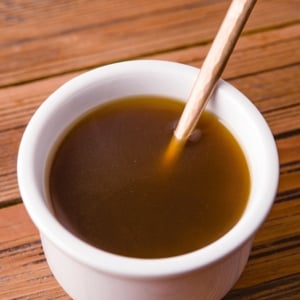

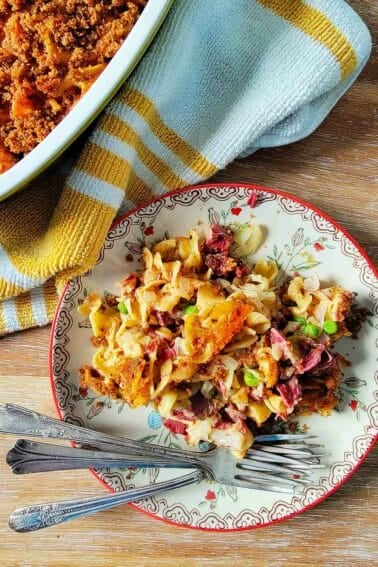
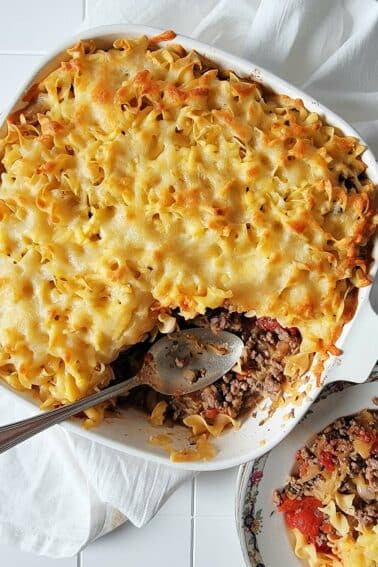
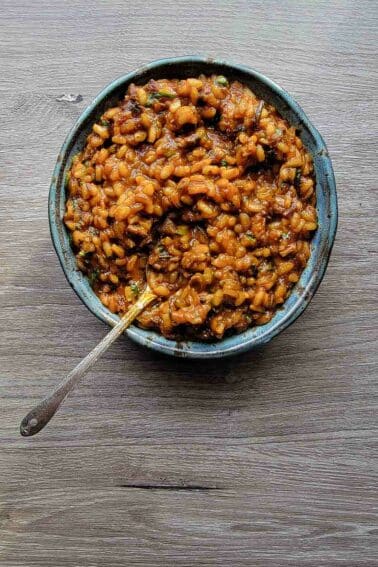
Hank, when you say “gnarly, sinewy bits and trim not even fit for the grinder”, do you even mean the hard white fat from a deer? Thank you!
Lisa: No, I don’t consciously put fat in stock. Sometimes it gets in there, but not on purpose.
Great recipe! Love making this every year with all the bones from my deer. Feels great to use as much of the animal as possible. Super grateful to Hank for teaching me how.
Amazing recipe for a great base for many dishes.
Hank, what do you think about making this in a crock pot? Thank you!
Best,
Lisa
Lisa: Should work fine.
I am currently making this recipe and so far, so good….it tastes great and the house smells amazing! Do you have any recommendations for storing this broth? We are debating over canning vs freezer bags…
Thank you, and thanks for a great recipe!
Kris: Canning all the way, if you have a pressure canner. If not, then freezing.
I lost a lot of volume overnight, likely because to achieve that shimmy-not-roil on my gas stove I had to leave the lid just a hair off the pot. If I want to add volume, how should I do so? Add the bones to another stock pot of cold water and re-boil then shimmy? Thank you
M: I’d sample the broth as is. It might be perfect now. You are going to use volume a lot overnight. If you need more volume, add water and the vegetables at the same time.
Will do, thanks so much! 🙂
Is it okay to use the beck with the spinal cord? Someone told be maybe best to not. I think because of the possibility of waisting disease.
When I make chicken or turkey, I want it. So just checking.
Yvonne: If you live in an area with Chronic Wasting Disease, then yes, it is a good idea to toss the spine, unless your deer tested negative. Antelope are not affected by it, as a side note. And there are many states that don’t have CWD. Depends on where you live.
I think that it doesn’t really matter if you use bones that are raw or not, oven roasted or even smoked on the grill for a few minutes. They all can produce amazing results, (better than anything you can buy). I don’t even think the species matters in some cases. You can roast the bones of different animals together, for a, “universal stock”! You can even go in an Asian direction as Hank mentions, but you can give Any stock Asian flavor simply by adding garlic and ginger when you cook a specific dish.
Amazing
Hands down some of the best venison broth. Our second year making it and pressure cooking it for storage. It never lasts a year and we use it for soups and stews
The tips in here improved my stocks.
Hello!! I made an attempt at your Dark Venison Broth from Buck, Buck, Moose, just last night, and I used 5 lbs of meaty pronghorn antelope bones, and after roasting the bones, I noticed a very distinct strong animal scent, but I tasted the meat that was on the bones, and it was very tasty and didn’t taste gamey at all. I proceeded to very gently simmer the bones for 12 hours, and added in a little apple cider vinegar (which some bone broth recipes call for to help extract more nutrients from the bones), onions, onion skins, garlic, carrots, celery with the leaves, black pepper, fresh rosemary and bay leaves. The musty animal scent remained throughout the entire simmering time, and the scent reminded me of how the animal smelled before it was gutted and skinned….a very distinct wild animal/antelopey scent, which is very off-putting and unappetizing! We butchered our own animals, which were quartered and put on ice in the field, then we spent 2-3 days cutting up the meat at home, which was vacuum sealed and put into the deep freezer; the animals were hunted in September, 2019, so the bones have only been in the freezer for 4 months, and the meat that was cut off of the same bones is not gamey and does not have the same scent the bones put off… Have you had this happen before, and do you know what the possible cause could be? Is this scent from the marrow? Is there any way for me to remedy the broth at this point? The broth has been in the fridge overnight, and I plan on scraping off the fat when I get home tonight, and may try adding in some red wine and more herbs, but I also feel hesitant to waste more ingredients, if the strong musty animal scent remains… Thank you for any help you can offer!! This is my second attempt at broth with antelope bones, and while this batch is definitely better than my first, it still smells really strange!!
On a more positive note, I absolutely LOVE your cookbooks, and have made several recipes from Buck, Buck, Moose and all have turned out like delicious restaurant quality meals, using both venison and antelope! I love your recipes, and your writing and I’m VERY excited to try the Shaking Venison and the Venison Bolognese recipes next!!
Hollie: I’ve had that happen with just the bones, but it mellows out over long cooking and then the vegetables/herbs really takes care of it. I’ve never had it smell off after that process. Weird.
I’ve made LOT’S of stock and soup – but this was my first attempt at Venison bone stock. I do NOT like the smell of venison when it is cooking – – – and I did let this stock go overnight – was SO SURPRISED how yummy it is!! I had three coffee mugs of stock in my taste testing!!!!
Thank you for sharing your experience in this recipe and tips. I am SO thrilled to be able to use more and more parts of the harvest.
I regularly save the chopped off ends of clean onion and the skins. I add any other veggie scraps like celery leaves and carrot tops. By keeping a bag in the freezer – I can add to it each time I have good looking veggie scraps. Makes the BEST bone broth!! Those onion tops are dynamite in the bone stock. I like that you add them in the last hours of cooking. I do too.
Today, I am using the lovely 11 quarts of stock to make canned Vegetable/Venison soup!!!!! Yay!
Thanks again!
Carol
With all the worry about CWD in venison, is it ok to use cut bones which expose the marrow where as I understand it, the disease originates from? and some states will not allow you to bring whole deer across state lines, only fully processed, no bones, but I know the marrow of beef is the prize and adds tons of flavor to a beef stock,
Thanks, Bart
Bart: That is an issue, and something you will have to decide for yourself. I hunt in a place with no CWD.
How slow is slow to bring Venison stock to simmer. I am 2 hrs in and still coming up to simmer. Excited
Eric: That works.
how do you reduce it. simmer? boil? on the stove top in a pot? Cock pot?
we think we added to much water or we should have found a calf foot to put in it.
Chris: Let it steep, steam, not boil, uncovered on the stovetop until it reduces to where you want it.
Hank, your recipes are PHENOMENAL! Thank you! Regarding your venison stock (or any stock, for that matter), how far down do you reduce it after removing the bones/veggies? My only experience with stock is of a commercial nature (bouillon tends to look pretty much watery), so I’m kind of guessing at the reduction. I can’t wait, as I’m LOVING the smell coming from my stove right now!
Randy: You let it cook slowly on the stovetop for hours and hours, and that reduction makes a great broth. If you don’t do that, it’s a good stock.
We have been hunters, foragers and gardners for a long time. I could never get my husband to save me the bones. This time our neighbors gave us a small whitetail hind quarter so I asked him to please save the bines and pieces. I now have a beautiful smelling bone broth in my Crock. I cant wait to try this yummy stuff. Hopefully I will be make more tonight as he cuts up the other quarter. Thank you for this recipe.
My husband just got a deer and I asked for bones to make this. I’m a little nervous since the only soup I’ve ever made without bullion or premade broth is chicken noodle soup. Fingers crossed this comes out great so I can use it for other soups and stews!
Thank you for this! A family member just processed a deer and I took all the bones and meat that wasn’t suitable for the grinder. I knew there HAD to be something I could make lol. I’ll be gifting some of this broth back to him.